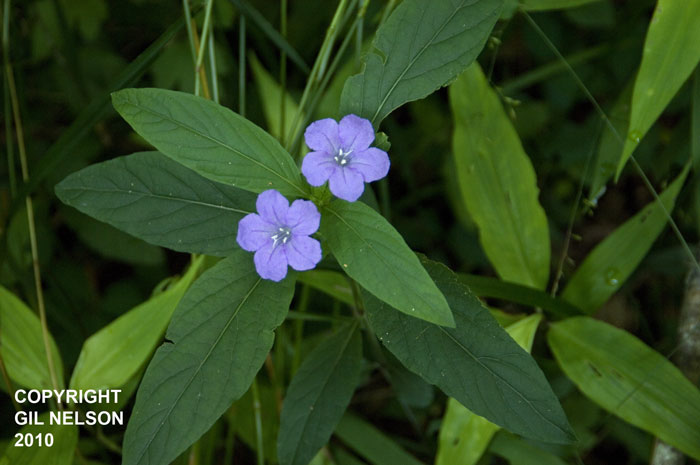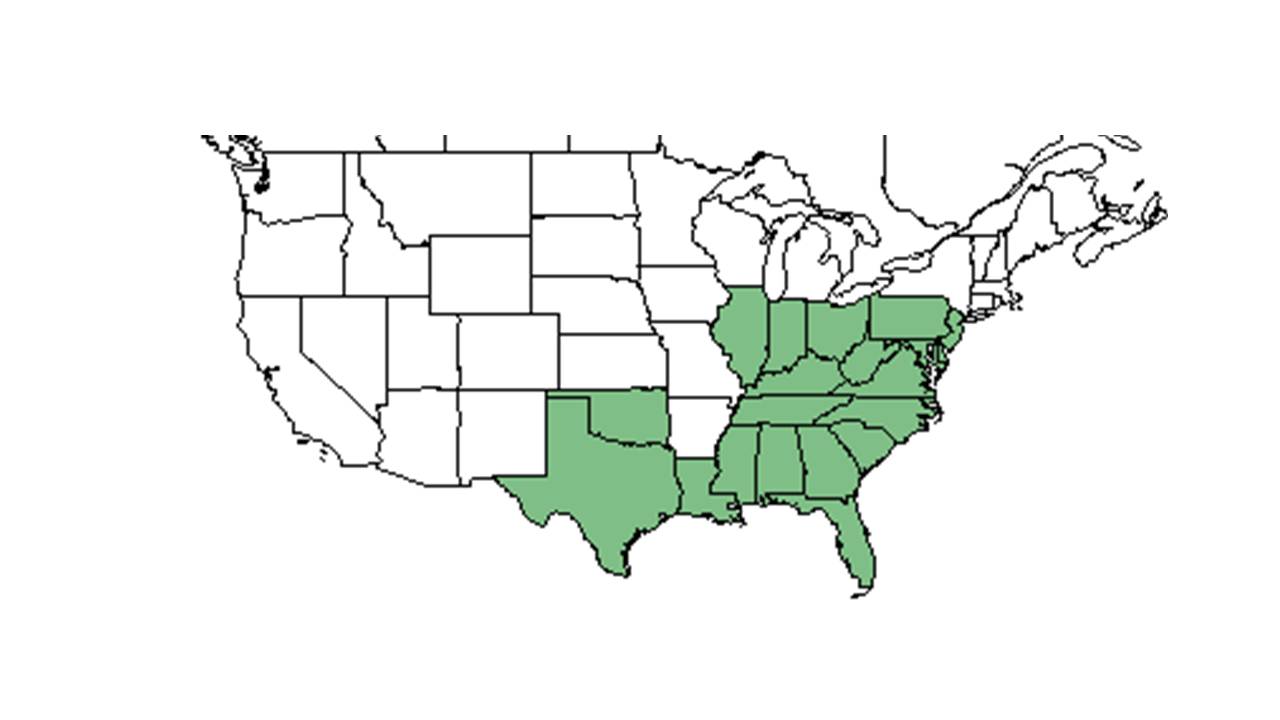Ruellia caroliniensis
| Ruellia caroliniensis | |
|---|---|

| |
| Photo taken by Gil Nelson | |
| Scientific classification | |
| Kingdom: | Plantae |
| Division: | Magnoliophyta – Flowering plants |
| Class: | Magnoliopsida – Dicotyledons |
| Order: | Scrophulariales |
| Family: | Acanthaceae |
| Genus: | Ruellia |
| Species: | R. caroliniensis |
| Binomial name | |
| Ruellia caroliniensis (J.F. Gmel.) Steud. | |

| |
| Natural range of Ruellia caroliniensis from USDA NRCS Plants Database. | |
Common name: Carolina wild petunia
Contents
Taxonomic notes
Description
R. caroliniensis is a small perennial varying 31 to 52 centimeters tall with oval leaves 6.7 to 7.5 centimeters long. The bluish-purple flowers bloom in early spring until late summer with seed capsules 0.4 centimeters wide and 1.3 centimeters long with brown seeds enclosed (Wilson et al. 2004).
"Perennial herbs. Leaves opposite, acute or obtuse, entire or undulate, base cuneate to attenuate, sessile or petiolate. Flowers in dense glomerules or in open cymes. Calyx tube short, lobes 5, elongate; corolla blue or rarely pink, funnel form, with tube, open throat, and 5 subequal lobes; stamens 4, included, anther locules parallel; stigmas 2-cleft. Capsules brown or yellow brown, compressed, ellipsoid-obovoid; seeds several, brown or gray." [1]
"Pubescent perennial, 1-6 dm tall. Leaves ovate, lanceolate, or elliptic, to 1-cm long and 4.5 cm wide, pubescent or glabrate, petioles to 12 mm long. Flowers in sessile or subsessile glomerules at middle and upper nodes. Calyx lobes usually hirsute, linear-setaceous, 15-22 mm long, less than 2 mm wide; corolla 2.5-4.5 cm long, tube longer than throat, lobes 5-15 mm long; ovary pubescent. Capsules usually glabrous, 12-16 mm long, ca. 5 mm broad; seeds brown, 2-2.5 mm broad." [1]
Distribution
R. caroliniensis is vulnerable to soil disturbances and is an indicator of native longleaf pine sites in southwestern Georgia (Kirkman 2004).
Ecology
Habitat
In the Coastal Plain in Florida and Georgia, R. caroliniensis can be found in the edges of wooded floodplains, mesic hardwood floodplains, drying sand of open woodlands, flatwoods, sandy alluvial banks, shallow marshes, and on bluffs along the Apalachicola River (FSU Herbarium). Soils include sandy loams, sand, and loamy sand (FSU Herbarium). Associated species include oak, hickory, dogwood, pine, juniper and magnolia (FSU Herbarium).
Phenology
Flowers in August (FSU Herbarium).
Seed dispersal
Seed bank and germination
Fire ecology
It was observed resprouting one month after a fire in July of 1993 (Pavon 1995).
Pollination
Use by animals
Diseases and parasites
Conservation and Management
Cultivation and restoration
Photo Gallery
References and notes
Kirkman, L.K., K.L. Coffey, R.J. Mitchell, and E.B. Moser. 2004. Ground Cover Recovery Patterns and Life-History Traits: Implications for Restoration Obstacles and Opportunities in a Species-Rich Savanna. Journal of Ecology 92:409-421
Florida State University Robert K. Godfrey Herbarium database. URL: http://herbarium.bio.fsu.edu. Last accessed: July 2015. Collectors: Lisa Keppner, Ed Keppner, Loran C. Anderson, R.K. Godfrey, Cecil R Slaughter, Jimmy Meeks, R. Komarek, R. A. Norris. States and Counties: Florida: Bay, Dixie, Franklin, Gadsden, Leon, Liberty, Marion, Okaloosa, Washington. Georgia: Grady. Compiled by Tall Timbers Research Station and Land Conservancy.
Pavon, M. L. 1995. Diversity and response of ground cover arthropod communities to different seasonal burns in longleaf pine forests. Tallahassee, Florida A&M University.
Radford, Albert E., Harry E. Ahles, and C. Ritchie Bell. Manual of the Vascular Flora of the Carolinas. 1964, 1968. The University of North Carolina Press. 973. Print.
Wilson, Sandra B. and P. Chris Wilson. 2004. Growth and Development of the Native Ruellia caroliniensis and Invasive Ruellia tweediana. HortScience 39:1015-1019.